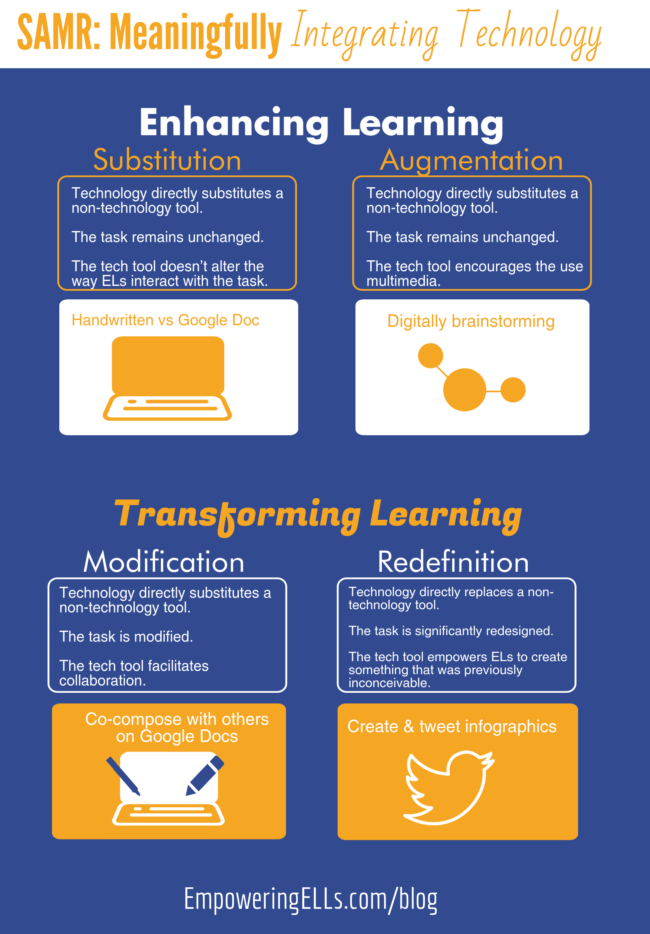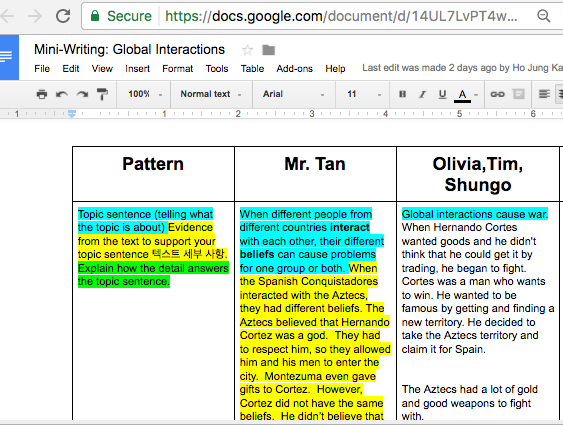This is Part 13 of the Transforming Instruction Through Technology series. This article focuses on meaningfully integrating technology to design learning experiences called the SAMR (Substitution, Augmentation, Modification, and Redefinition) Model.
Bells and Whistles
At one of my previous schools, the principal would point to our LCD projectors and boast that we had technology in the classrooms. Little did I know that simply having technology in the room does not qualify as quality integration.
I later learned about Dr. Ruben Puentedura’s SAMR model, a model for meaningful technology integration. With it, I’ve learned to distinguish the bell-and-whistle-level integration (ie: projectors) from learning experiences that effectively raise ELs’ achievement using technology.
SAMR Model Explained
S: Substitution
In Substitution:
- Technology directly substitutes a non-technology tool,
- The task remain unchanged, and
- The tech tool doesn’t alter the way ELs interact with the task.
For example, say that an English teacher wants students to write an analytical essay after reading a piece of literature. Instead of having students write physically in a notebook, they compose on a Microsoft Word Document. Writing digitally is a substitute for physically writing, but the task remains unchanged.
A: Augmentation
In Augmentation:
- Technology directly substitutes a non-technology tool,
- The task remains unchanged, and
- The tech tool encourages the use of multimedia
Sticking with the literary analysis essay example, the ELs would plan their ideas using an online mind mapping program called Mindmup. Traditionally, ELs would have brainstormed their ideas in their notebooks or on poster paper. However, with Mindmup, they can now link to images, websites, and videos to further communicate their ideas.
Weaving multimedia into learning experiences is a distinguishing feature of Augmentation. The task of writing the literary analysis essay remained unchanged, but the brainstorming process here is enhanced by technology.
During the Substitution and Augmentation phases, technology is there to enhance learning. ELs use technology to better understand content and facilitate engagement with it. However, in the following two phases, technology serves to transform learning by empowering students to use content knowledge to collaborate with others and engage with authentic audiences.
M. Modification
In Modification:
- Technology directly substitutes a non-technology tool,
- The task is modified, and
- The tech tool facilitates collaboration.
Using the same example, students would begin to write with others on Google Docs. This platform allows students to collaboratively compose text in real-time. Students share ideas, type them, and revise writing simultaneously on a single document. No more need to email different versions. Google Docs has transformed the stagnant task of writing in isolation into a collaborative experience that provides opportunities for ELs to think critically and learn social skills.
The image below is a screenshot of a Google Doc where three 6th graders collaboratively composed a paragraph after reading a shared text about Hernando Cortez and his interactions with the Aztecs. The rich conversation and critical thinking that sprung from this collaborative experience enhanced my ability to teach academic writing skills.
R. Redefinition
In Redefinition:
- Technology directly replaces a non-technology tool,
- The task is significantly redesigned, and
- The tech tool empowers ELs to create something that was previously inconceivable – e.g. connecting ELs with an audience outside of the classroom
Traditionally, a literary analysis essay is created in class, worked on at home, and submitted to only one reader – the teacher – who assesses it and provides a grade. What if we reimagined this task? How can technology help create something that:
- develops ELs’ literacy skills while
- empowering them to engage with real issues that matter?
Instead of writing a literary analysis essay on the concepts in To Kill a Mockingbird, what if we turned it into a unit of exploring social justice issues?
Bret Gosselin did something just like that for his students who enrolled in a remedial writing course designed to help them pass the state standardized assessment. Instead of rounds of writing literary analysis papers, Gosselin read texts related to social justice issues such as To Kill A Mockingbird and newspaper articles.
Then, students self-selected a social justice topic to explore. They wrote essays to evaluate the causes and consequences, composed narratives describing the life of a person who experienced these injustices, and drafted persuasive essays suggesting ways to address the injustices. Additionally, they used Piktochart to create infographics that visually communicated their ideas. Students’ writings and infographics were housed on their websites, which provided an authentic audience that focused students’ work.
The distinguishing feature of Redefinition is that technology encourages students to engage with real-life problems and interact with authentic audiences. Gosselin’s unit was about learning from and addressing a social injustice – not just about learning literacy skills to pass a state standardized assessment.
I’m not sure if Gosselin had his students do this, but they could go one step further to raise awareness of the problems by tweeting their infographics to organizations that are fighting to eradicate their respective issues. Doing so would honor Redefinition’s principle of using technology to create something that was previously inconceivable. For some, it might mean just raising awareness about the social justice issues. For the ELs in Gosselin’s class, it might be the new confidence that they have a voice magnified by technology.
I recommend reading about Gosselin’s year-long unit in his guest post for the Buck Institute for Education, which also links to some of his students’ infographics.
Transformative
During Modification and Redefinition, learning becomes a transformative experience for ELs because they use technology to communicate their ideas and collaborate with others – not just to memorize language. Additionally, the authentic audiences provide a purpose for students to communicate. Often, an audience of anyone besides the teacher, from a classmate next to them to a virtual community, can make a world of difference in how well an EL participates and absorbs the learning material.
A Checklist or a Continuum
The SAMR Model is more of a continuum of meaningful technology integration than a static structure of teaching. Just like how we move up Bloom’s taxonomy from Remember to Create, we want to move from Substitution to Redefinition on the SAMR Model because it fosters greater critical thinking and creativity. If we remain stuck in Substitution and Augmentation, we relegate technology to the task of consuming information only. If we ascend to Modification and Redefinition, we encourage students to use technology to collaborate and think critically when producing their own content.
Ultimately, we want students to be what I call prosumilators – people who can critically consume information and collaborate with others to produce meaningful content.
Takeaways
Effective technology integration unlocks doors that invites students to explore their interests. It isn’t about what technology students use or how expensive the toys are that our schools purchase. It is about using technology to raise ELs’ achievement.
More importantly, meaningful tech integration empowers students to act with confidence from the understanding they’ve gained and interact with audiences outside the classroom on issues that matter to them. Technology integration isn’t just about raising ELs’ achievement but kindling their participation in a digital life.
Puentedura’s SAMR model provides a lens to more clearly see the transformative role that technology can have in teaching and learning if mindfully weaved into the curriculum.
If you’re interesting enhancing learning for ELs by integrating technology, please consider reading ELL Frontiers: Using Technology to Enhance Instruction for English Learners by Heather Parris, Lisa M. Estrada, and Andrea Honigsfeld. By purchasing the book, you also support this blog.



